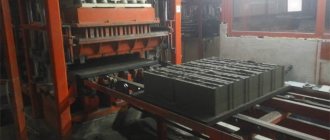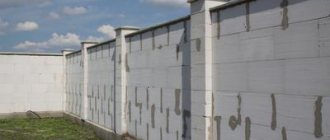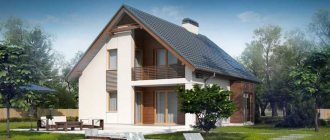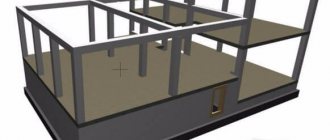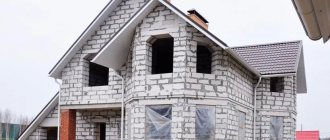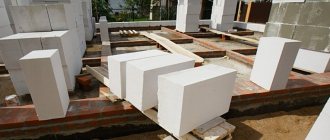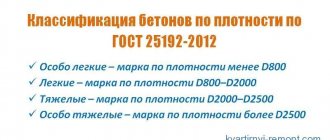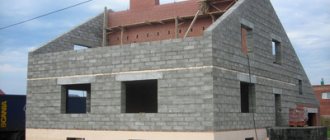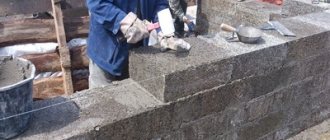Recently, the demand for lightweight concrete blocks has increased significantly, catching up and even surpassing the demand for a more traditional building material - brick. There is also competition within the group of cellular concretes, and aerated concrete still holds the lead. It is followed by foam concrete, but polystyrene concrete is about to overtake it in popularity. This building material is about half a century old and has shown itself well during this time: at a low price, it is durable and provides excellent thermal insulation. A cottage with an area of 120 m2 can be built in just 2.5-3 months using polystyrene blocks. These advantages are worth taking a closer look at the properties of the material and understanding whether it is worth building a house from polystyrene concrete, and what features of the material you will have to deal with. Let's look at polystyrene concrete as the main material for building a house.
What is polystyrene concrete made of?
Polystyrene concrete arose as an attempt to produce a building material that would not require additional insulation of the walls from the outside. Polystyrene beads were added to the concrete solution, which provided the material with outstanding thermal insulation properties. The composition of a modern polystyrene concrete block includes cement, sand, water, polystyrene foam granules, special plasticizing and air-entraining additives and sometimes surfactants (surfactants), which increase the adhesion of the concrete solution and foam balls.
Depending on the proportions in which the components for the block were taken, the material can be used for the construction of load-bearing walls, partitions, or as insulation. One block of expanded polystyrene replaces 20 bricks, and accordingly the speed of building construction increases many times over.
Strength of polystyrene concrete
Another important indicator of a building material is strength. While we are comparing aerated concrete with a polystyrene concrete block, I believe that there is simply nothing to talk about.
The expanded polystyrene concrete block itself has unique strength characteristics among all building materials. No, it is not stronger than steel and monolithic reinforced concrete. It is no lighter than insulation, and not as flexible as wood. He's just not like that, and like that - at the same time.
A material based on foamed polystyrene, mixed with cellular concrete, has the property of not collapsing, but of cushioning under loads
. This can be checked by dropping a block of aerated concrete and foam concrete from a height - the aerated concrete will split into pieces, and the PPSB will bounce like a ball. At most, the corner of the block will wrinkle a little.
Crushing a block of polystyrene concrete, or splitting it with a sledgehammer, is also a problem, since, evenly distributing the load
between all the polystyrene balls inside itself, this block resists any mechanical impact firmly and stubbornly. Which is very important when building in seismically dangerous areas, and not dangerous ones, however, it is also important.
Pros and cons of polystyrene concrete
Features of the production technology and composition of the blocks allow us to talk about the numerous advantages of the material:
- Excellent thermal insulation qualities. According to manufacturers, a wall 20 cm thick will be enough to provide the required heat transfer resistance in regions with mild climates. In regions with harsher winters, a wall 30 cm thick will be needed, but the most common option in this case is 20 cm of polystyrene concrete and foam insulation. The thermal conductivity coefficient of the material depends on the density, but in any case it is several times lower than that of many analogues;
- Excellent soundproofing qualities. A 20 cm thick wall can block sound of 72 dB;
- The light weight of the blocks and their large dimensions can significantly simplify and speed up the construction of a house. There is no need to use complex heavy equipment. Moreover, it is easy to give the blocks the required shape, so in fact, you can build a house from them even with complex architectural elements, however, the consumption of material will increase greatly;
- High resistance to moisture, resistance to mold and rodents;
- High frost resistance. The material can withstand up to 100 freeze/defrost cycles, which is three times more than the same foam concrete;
- The material belongs to the G1 flammability class, i.e. it is practically not flammable. Experiments confirm that after an hour's exposure of a polystyrene concrete wall to a temperature of 10,000 oC, it does not collapse. True, there is another side to the coin. If a building survives a fire, it will most likely survive, but will become unsuitable for further use, since the walls will lose sufficient strength;
- No shrinkage;
- Low load on the foundation;
- Acceptable strength;
- The ability to create a monolithic house from polystyrene concrete, without cold bridges;
- Low price.
Main disadvantages:
- The low vapor permeability of the material will not allow excess moisture from the room to pass through it, so it is necessary to equip a good ventilation system, otherwise the problem of increased humidity and stuffiness inside the house will be ensured;
- The quality of the block greatly depends on the accuracy of adherence to production technology. If the ratio of concrete and foam granules has been violated, then the strength of the block will be low, and if there is insufficient adhesion, the granules may even begin to fall out of the block. When purchasing, always inquire about the quality certificate;
- With prolonged exposure to high temperatures, the foam balls burn out, leaving essentially only a concrete frame. Its strength and thermal insulation are not high and do not allow it to be used as an external wall. However, facing the walls with non-flammable materials and high-quality plaster can protect the walls well from fire, and the very ability of the walls to withstand high temperatures is worth a lot, so this drawback cannot be called significant;
- The low density of the material complicates the installation of windows and doors. If you do not take into account the numerous features of the installation, then within a couple of years you may encounter loose fasteners; The walls must be plastered. The layer of plaster inside is at least 20 mm, outside – at least 15 mm, and adhesion with the plaster solution is not entirely ideal.
The properties of polystyrene concrete allow it to be considered as a material for the construction of load-bearing walls of a house. It can also be used for the construction of fences, sheds, garages and as thermal insulation.
Disadvantages of aerated concrete and foam concrete
Polystyrene concrete block evolved from aerated concrete (gas block) and foam concrete (foam block). Let's consider the most common and popular - aerated concrete, which has its drawbacks, of which there are many.
Laying aerated concrete blocks
1 And the first of them is sound permeability
. There is no need to explain anything to people who have the good fortune of living in a multi-story building made of aerated concrete, when you can talk to your neighbor from the apartment behind the wall without even raising your voice.
2 The second disadvantage is the loss of the ability to retain heat
, directly proportional to the moisture content of the aerated concrete block. And at the turn of the seasons, this hydration occurs by itself, and even without your direct participation. Therefore, unfortunately, an aerated concrete block cannot do without additional insulation.
3 And the third minus is fragility
. Anyone who has tried to hang something more serious than a painting on an aerated concrete wall understands what I’m talking about now. The anchors fall right out with pieces of the walls.
Monolithic houses made of polystyrene concrete
Polystyrene concrete, like expanded clay concrete, allows you to build houses using monolithic technology. The composition of the material is still the same, only individual blocks are not made from it - it is poured into finished formwork, forming the walls of the house.
The advantages of this solution:
- Absence of cold bridges, because there are no seams between the blocks;
- High speed of house construction;
- Minimum chance of shrinkage. Polystyrene concrete blocks are not capable of shrinkage - it can occur due to the use of mortar;
- High strength and durability;
- Uniform distribution of load on the foundation;
- Possibility to integrate some communications into a monolithic wall.
The main disadvantage is the complexity of construction. Since the walls need to be poured in one go, you will need a large amount of mortar and special equipment, so you can’t do it yourself, but you can build a house from blocks yourself.
Conclusion
As a result, the polystyrene block is superior to aerated concrete
in almost all important parameters - sound insulation, thermal resistance, moisture resistance, strength and mechanical resistance to deformation.
And what is most important - with all its advantages, it is practically no different in price from its parent, and when built from PPSB-facade blocks, there is a cost benefit
home, taking into account the exterior decoration is obvious. Why not a contender for universal love and respect? It’s just that few people know about him yet.
You can order a calculation using two materials - aerated concrete and polystyrene foam PPSB facade, to compare the difference in the cost of the house.
Density, strength and frost resistance of polystyrene concrete
GOST R 51263-99 standardizes the main performance indicators of polystyrene concrete. According to it, brands are determined by density from D150 to D600, where the number means density in kg/m3. The lower the density, the higher the thermal insulation qualities of the material and the lower its strength.
The standard also defines compressive strength classes from B0.5 to B2.5: the higher the coefficient, the greater the load the block can withstand. Also, compressive strength is sometimes designated by the letter M with a coefficient from 2 to 5. This marking is introduced for a material that is designed without taking into account the requirements of ST SEV 1406, its strength is lower.
Frost resistance is determined by the cycles of freezing and defrosting that the unit can withstand, maintaining its basic performance qualities. For polystyrene concrete, frost resistance ranges from F25 to F100 and increases with increasing material density.
Based on density and a number of indicators that depend on it, polystyrene concrete is divided into three classes:
- Thermal insulating polystyrene concrete with a density of D150-D200 with low strength and low thermal conductivity coefficient (0.055-0.065 W/m*K). Used for insulation of heat-conducting systems, external walls and ceilings;
- Thermal insulating structural polystyrene concrete with a density of D250-D350 can be used for thermal insulation of non-load-bearing and self-supporting walls. In some cases, D350 blocks can even be used for the construction of external load-bearing walls, provided that the building is low-rise and the external cladding is light;
- Structural thermal insulating polystyrene concrete grades D400-D700 are used for the construction of load-bearing walls of low-rise buildings (up to 3 floors) and non-load-bearing walls of multi-storey buildings. Monolithic buildings are also erected from polystyrene concrete of these brands.
Preparing the mixture
The main part of the solution is foam chips. It can be of two types:
- ready-to-use granules;
- crumbs can be obtained by crushing the foam in a special crusher.
Crushing polystyrene foam will be more profitable than buying ready-made granules. Moreover, you don’t have to use whole sheets - any leftovers will be used.
Ratio of components for preparing concrete:
- 1 part water;
- 1 part cement;
- 2 parts sand;
- 4 parts crumbs.
To prepare the solution, it is better not to skimp on the quality of cement and take the M500 brand. The fact is that the use of polystyrene foam in itself reduces the strength of the finished solution, so the cement must be of a higher grade than usual. In this case, polystyrene foam added to concrete will not reduce its strength so much.
Styrofoam
Pros and cons of manual crushing
Self-leveling floor with marble chips Before installing a floor with marble chips, you should find out
Fluidation of concrete - features and advantages of the material Fluidation of the surface of concrete - a procedure that is impregnation with fluorosilicates
As already written above, the base of foam concrete is crumbs, which you don’t have to buy in a store, since you can easily make it yourself. However, this approach has a number of disadvantages:
- higher material consumption compared to finished products;
- the strength of the finished concrete will be less. This is due to the fact that the solution will contain chopped granules and the percentage of water absorption will increase. In addition, granules of different sizes also affect this.
The advantages are that it turns out to be much more economical. And you can use any foam plastic.
Preparation of the solution
The kneading technology itself does not differ from the classical one. It is best to use a concrete mixer for mixing. And the sequence of work looks like this:
- Cement and sand are loaded into the tank;
- after this, foam granules are added;
- then the mixture is mixed well and water is added to it.
Now you just need to wait until the solution is well mixed and that’s it - it can be used for work.
Important! To neutralize the main disadvantage of foam concrete - low strength, you need to add special strengthening additives to the solution.
Finished granules
Types of polystyrene concrete
Polystyrene concrete is produced by manufacturers in the following modifications:
- Typically, blocks with dimensions of 588*300*188 mm, 588*380*300 mm and 588*300*285 mm are used for laying walls and partitions;
- The partition block is thinner and has dimensions of 588*300*92 mm and 588*300*135 mm.
Building blocks
- this is the ability of a material to transmit or retain steam as a result of the difference in partial pressure at the same atmospheric pressure on both sides of the wall.
Many manufacturers like to boast that their material has “high” vapor permeability, and thereby mislead the client. Big doesn't mean good or bad.
For example: in SIP panels, permeability is close to zero. This means that the amount of moisture that was in the panel at the time of its production remains practically unchanged. Those. nothing penetrates from the room into the panel and nothing escapes through the panel into the atmosphere. Similar thermal insulation is used in thermoses. They retain heat very well, but for a comfortable stay, you will have to seriously think about the ventilation of the house.
The high vapor permeability of aerated concrete (0.16 mg/m*h*Pa) also entails additional tasks and costs. For example, if you decide to line the walls of your house with brick, then you will have to create a ventilation gap (usually 2 - 5 cm) between the aerated concrete and the brick. The vapor permeability of brick is lower than that of aerated concrete. If you do not provide a ventilation gap, then condensation will form on the outside of the aerated concrete and if it is not removed, it will lead to premature destruction of the wall. In such a multilayer wall, when calculating the thermal protection of a building, the thermal conductivity of the brick is not taken into account. In other words, you must understand that the brick will be purely decorative, the aerated concrete blocks will be thicker than they could be, the foundation will have to be made wider, and tying the brick to the aerated concrete will become more complicated. As an option, aerated concrete walls are impregnated with a vapor-impermeable primer. That is, you “clog” the walls and they stop breathing. It is advisable to “clog” walls only with dried aerated concrete. Manufacturers claim that aerated concrete dries to its natural moisture content in 2 to 3 heating seasons. This means that 2-3 years of your life in an unfinished house will be with increased heating costs and without finishing.
The human body has been accustomed to living in wooden houses for centuries, and we are accustomed to comparing the microclimate of the “concrete jungle” with the microclimate of a wooden house. The vapor permeability of pine across the fiber is 0.06 mg/m*h*Pa, for polystyrene concrete it is 0.08 mg/m*h*Pa. With this comparison, we can say that most likely the microclimate of a house made of polystyrene concrete will also be close to the level of a wooden house. In addition, if you decide to plaster the walls or cover them with facing bricks, the construction of the wall will be greatly simplified. Since the vapor permeability of brick is higher than that of polystyrene concrete, a ventilated gap is not needed, and tying the brick to the blocks using a basalt mesh simplifies the reinforcement. In addition, in this case, the brickwork will participate in the thermal protection of the building.
What to consider when choosing and purchasing polystyrene concrete?
Recently, a lot of low-quality products have appeared on the market, which is caused by the growing demand for polystyrene concrete. Some companies that previously produced foam blocks have now begun to produce polystyrene concrete, and often attempts to quickly please the market lead to a deterioration in product quality. What should you pay attention to and what should you check when purchasing?
- Uniform filling of concrete granules; uniformity of granules;
- The weight of the block corresponds to the specified density;
- When ordering polystyrene concrete, you need to find out as much information as possible about the manufacturer, so you can and should safely ask where the production facilities are located and inquire about the manufacturing features. A normal manufacturer can invite you to production and demonstrate the products, and will also tell you what thickness of walls it is better to make, what density of blocks to choose, advise how best to attach shelves, what adhesives and solutions are best to use when laying - in general, you should answer any question;
- The quality certificate is another important point. But even its presence is not always a 100% guarantee of quality. If you are dealing with a distributor and he shows you a quality certificate from the manufacturer, then it doesn’t hurt to check with the manufacturer that he is cooperating with this seller.
Features of building a house made of polystyrene concrete
Building a house is a complex multi-stage process that requires at least basic specialized knowledge. In general terms, building a house made of polystyrene concrete looks like this:
arrangement of the foundation. Since the overall weight of the structure is small, a columnar, shallow strip or pile foundation can be used. For complex types of soil, it is better to choose a screw pile; construction of walls using the chosen technology: from blocks, with removable or permanent formwork. Construction from blocks begins with waterproofing work and determining the highest place from which the laying of walls begins. When laying, verticality and horizontality are strictly observed using a fishing line and a level. To increase strength, reinforcing mesh can be laid horizontally. If blocks with solid voids are used, vertical reinforcement is performed. The thickness of the mortar seam is no more than 8 mm; it is better to use special glue. Monolithic walls are erected using removable formwork made of 15 mm thick plywood, which is protected from moisture with a polyethylene film. The plywood is held in place through the use of metal profiles; they are attached to the foundation with self-tapping screws or dowels. Sheets of plywood are attached to the profiles; first, external partitions are created, then internal ones. When pouring, the solution compacts well; the formwork can be dismantled after a few days. Instead of plywood, you can use brick walls - this is permanent formwork, and no façade cladding is required; The ceiling is made from special polystyrene concrete panels or also by pouring. Floor screeding is performed using standard methods; exterior finishing of a house made of polystyrene concrete is necessary. You can use decorative brick, siding, and plaster. Inside, you also first need a layer of plaster, then putty, and then whatever you want: wallpaper, painting, decorative plaster. A house made of polystyrene concrete can be built in a matter of months, and if all the features of the technology are observed, it will stand for decades. Most importantly, do not forget about high-quality ventilation and specific fasteners.
Advantages of polystyrene concrete PPSB
So, it’s time to improve everyone’s favorite aerated concrete. And the weakest link in this block is, oddly enough, the gas bubbles inside the concrete. It is because of their cellular structure that the whole set of negative characteristics that we are talking about occurs. Why is polystyrene concrete or expanded polystyrene concrete better?
The PPSB-facade block does not require insulation or finishing
1 Initially, the gas bubbles in it were replaced with polystyrene granules. Polystyrene is denser than air, which means it adds density to the block. The structure of the block already involves four different-density media - concrete, air bubbles, polystyrene balls, and carbon dioxide inside the balls. Since all these materials are thoroughly mixed, the block achieves the effect of attenuation of sound waves
. The sound is simply lost, like in radio waves in the bodies of stealth aircraft.
2 The thermal conductivity of the block also increases significantly due to this effect, but not only that - polystyrene foam itself is almost the most effective thermal insulator, and since the PPSB block is 90% composed of expanded polystyrene, the effect is obvious - heat loss is four times less
.
By the way, since expanded polystyrene also almost does not absorb moisture, the PPSB block is moistened three times less
than aerated concrete.
3 A house built from PPSB-facade blocks does not require insulation or exterior finishing
. That is why today the price of a stone house made of PPSB-facade blocks is almost equal to the cost of a house made of SIP panels or a frame one.
The cost of building a house using expanded polystyrene concrete blocks with a finished façade PPSB-façade is lower than using aerated concrete. And here's why - the facade will only need to be primed and painted; there is no need to insulate or plaster the house. You can save a lot by investing minimally in the exterior of your home.
